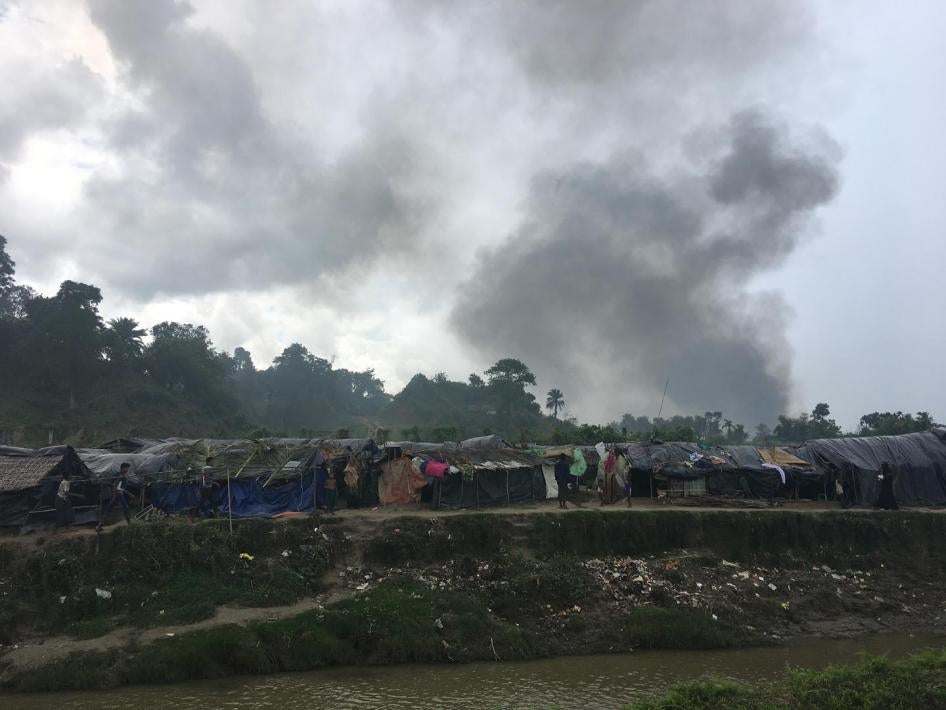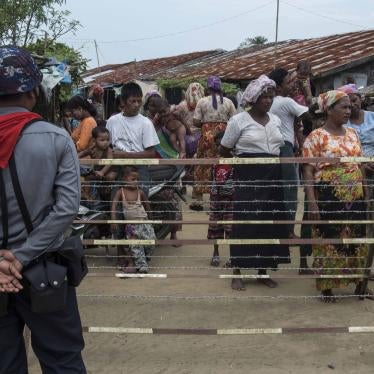(Dhaka) – The Burmese military is deliberately burning ethnic Rohingya villages near the Bangladesh border, Human Rights Watch said today. Such acts of arson, after forcing residents to leave their villages, appear central to the Burmese military’s ethnic cleansing campaign against the Rohingya Muslim population in Burma’s Rakhine State.
Human Rights Watch released new satellite imagery and sensory data showing that 62 villages in northern Rakhine State were targeted by arson attacks between August 25 and September 14, 2017. Human Rights Watch identified 35 of these villages with extensive building destruction from very high resolution satellite imagery, and an additional 26 villages that had active fires detected in near-real time with environmental satellite sensors.
“Our field research backs what the satellite imagery has indicated – that the Burmese military is directly responsible for the mass burning of Rohingya villages in northern Rakhine State,” said Phil Robertson, deputy Asia director. “The United Nations and member countries should urgently impose measures on the Burmese government to stop these atrocities and end the forced flight of Rohingya from Burma.”
Human Rights Watch conducted a detailed building damage assessment in 6 of the 35 affected villages and identified nearly complete destruction in each case. The total number of destroyed buildings was 948.
On the morning of September 13, Human Rights Watch observed from Bangladesh large plumes of thick, black smoke from the Rohingya border village of Taung Pyo Let Yar in Maungdaw township. A video confirmed to have been taken from a hill overlooking the village shows several buildings burning in the unoccupied village and two large, dark-colored trucks several hundred meters away. Village residents stranded at the border described the vehicles as “military trucks” that had previously entered the village. Three villagers who observed the fires from the hill said that the smoke came from fires set in village buildings.
Fatima, 50, who had fled Taung Pyo Let Yar, told Human Rights Watch that after she saw smoke rise from the village, she climbed a hill to see if her home was on fire. When she reached the top, she saw her home engulfed by a column of smoke. Other nearby homes were also burning. She said that she had fled on August 31 when trucks carrying Burmese soldiers arrived in the village. The soldiers jumped out of the trucks carrying guns, frightening her, so she ran several hundred meters into the “no-man’s land” at the Bangladeshi border. “When we see the army we just ran away from the village – hundreds ran,” Fatima said. “We just brought our children.”
Mohamed Sahed, 50, climbed the same hill and said that he saw his two trucks and a car burning in front of his house, which was also consumed by fire. He said he saw at least four soldiers in the village. His son, Mohamed Shufi, 24, said that earlier that morning he and two other villagers had re-entered Burma and were heading back to their homes to get wood for cooking at their temporary camp at the border. But when they were still hundreds of meters from the village, a half-dozen Burmese soldiers spotted them and hurled rocks at them using slingshots. The three villagers ran back across the border and hid.
Earlier in the week, Human Rights Watch directly observed a Burmese military patrol operating within 600 meters of Taung Pyo Let Yar. Rohingya refugees also said that they saw patrols of at least 40 Burmese soldiers operating within meters of the border fence and several hundred meters of the village nearly every day. Several people at the border said that a Burmese border guard police post was located within 200 meters of Taung Pyo Let Yar, and that since August 31, the Burmese military had routinely occupied houses in the village and used the border guard outpost.
Satellite detection of multiple active fires on September 11 and 13 suggest that villages in new areas of Maungdaw township are now being targeted for destruction. Because of heavy cloud cover, it is almost certain that the actual number of fire-affected villages in the townships of Maungdaw, Buthidaung, and Rathedaung is considerably higher. UN Secretary-General António Guterres and human rights chief Zeid Ra’ad al-Hussein have indicated that the Burmese military’s actions amount to ethnic cleansing. Burmese government statements seemingly support these conclusions. Zaw Htay, a Burmese government spokesman, told the media that of 471 villages targeted in “clearance operations” by the military, 176 are now empty and at least 34 others partially abandoned.
The Burmese military’s operations in northern Rakhine State followed a series of coordinated armed attacks by the Arakan Rohingya Salvation Army (ARSA) on August 25 against more than 30 Burmese government police stations and checkpoints, government offices, and an army base. The Burmese government alleges that Rohingya militants and villagers are responsible for burning buildings in villages across Rakhine State, but has so far failed to provide evidence of this claim.
Although “ethnic cleansing” is not formally defined under international law, a UN Commission of Experts has described ethnic cleansing as a “purposeful policy designed by one ethnic or religious group to remove by violent and terror-inspiring means the civilian population of another ethnic or religious group from certain geographic areas.… This purpose appears to be the occupation of territory to the exclusion of the purged group or groups.”
“The sightings of Burmese military vehicles and soldiers in a Rohingya village as it goes up in flames fills in some blank spaces of the overwhelming satellite imagery of destruction,” Robertson said. “Concerned governments need to convey the message to Burma’s Sr. Gen. Min Aung Hlaing and other senior commanders that they could be implicated in grave crimes unless they act swiftly to stop the atrocities and hold those responsible to account.”


















